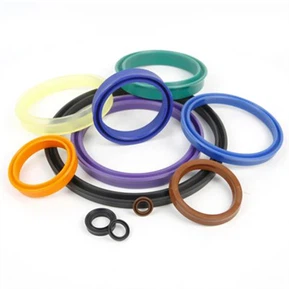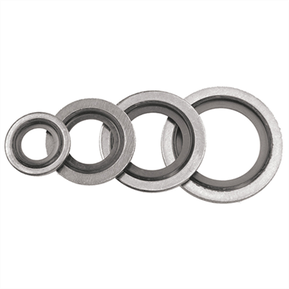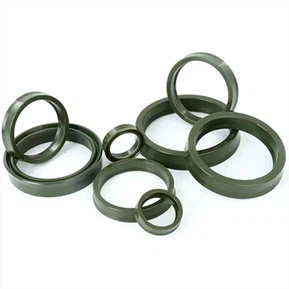Key O-Ring Dimensions to Measure
O-ring size is defined by two non-negotiable dimensions—you’ll need both to find a matching replacement:
- Inner Diameter (ID): The distance across the empty center of the O-ring (this ensures it fits around the component it’s sealing, e.g., a POC’s sieve bed tube).
- Cross-Sectional Diameter (CS): The thickness of the O-ring (this determines how well it compresses to fill gaps between mating parts; too thick/thin causes leaks).
Note: Avoid confusing these with Outer Diameter (OD)—though OD can be calculated (OD = ID + 2×CS), it’s not used for sizing standards.
1. Tools You’ll Need
For accuracy (critical for oxygen systems, where even small size mismatches cause leaks), use these tools (ranked by precision):
- Digital Caliper (Best): Measures ID and CS to 0.01 mm or 0.001 inches—ideal for medical/oxygen equipment.
- Manual Vernier Caliper: Slightly less precise than digital but still reliable for most applications.
- Ruler/Tape Measure (Last Resort): Only use if no caliper is available; accuracy is limited to ~1 mm, so avoid for high-pressure systems (e.g., oxygen tanks).
- Flat Surface: To lay the O-ring flat during measurement (prevents stretching or distortion).
2. Step-by-Step Measurement Methods
Follow these steps to get accurate ID and CS readings—never stretch the O-ring (this distorts dimensions):
a. Measure Inner Diameter (ID)
Method 1: Using a Caliper (Most Accurate)
- Lay the O-ring on a flat, clean surface (e.g., a table). Ensure it’s not twisted or stretched.
- Open the caliper’s jaws and place the inner edges of the jaws against the inner circle of the O-ring (see diagram below).
- Gently close the jaws until they touch the O-ring’s inner wall—do not squeeze hard (this deforms the rubber).
- Record the measurement (e.g., 20 mm or 0.787 inches). Take 2–3 readings and average them for consistency.
Method 2: Using a String (No Caliper)
- Cut a thin string (e.g., cotton thread) and wrap it tightly around the inner circumference of the O-ring (the empty center).
- Mark the point where the string overlaps, then measure the length of this marked section (inner circumference, C).
Calculate ID using the formula:\( ID = \frac{C}{\pi} \quad (\pi \approx 3.1416) \)
Example: If the inner circumference is 62.8 mm, ID = 62.8 ÷ 3.1416 ≈ 20 mm.
b. Measure Cross-Sectional Diameter (CS)
- Keep the O-ring flat on the surface. Pick a spot on the O-ring’s edge (avoid any nicks or damage).
- For a caliper: Place the caliper’s jaws perpendicular to the O-ring’s inner/outer circles (so you measure the “thickness” of the rubber).
- Gently close the jaws until they touch both sides of the O-ring (do not compress the rubber—this reduces CS and leads to undersized replacements).
- Record the measurement (e.g., 3 mm or 0.118 inches). Again, take 2–3 readings and average.
Pro Tip for Rulers: If using a ruler, place the O-ring upright (on its edge) and measure the distance between the top and bottom of the rubber—this approximates CS.
3. Match Measurements to Standard O-Ring Sizes
O-rings follow global size standards to ensure compatibility. The most common standards are:
- AS568 (U.S. Standard): Used for most industrial/medical O-rings (e.g., oxygen equipment). Sizes are labeled with a 3-digit number (e.g., AS568-214 = ID: 19.05 mm, CS: 3.53 mm).
- ISO 3601 (International Standard): Used globally, labeled with “G” + numbers (e.g., ISO 3601-G-20×3 = ID: 20 mm, CS: 3 mm).
How to Find the Standard Size:
- List your measured ID and CS (e.g., ID = 19.1 mm, CS = 3.5 mm).
- Use an O-ring size chart (easily found online via manufacturers like Parker or McMaster-Carr) to match your measurements to the closest standard size.
-
- Example: A measured ID of 19.1 mm and CS of 3.5 mm will match AS568-214 (standard ID: 19.05 mm, CS: 3.53 mm)—small differences (±0.1 mm) are acceptable due to rubber elasticity.
- For oxygen equipment: Ensure the standard size is compatible with your device (check the manufacturer’s manual—e.g., Inogen POCs often use AS568-169 or -214 O-rings).
4. Special Tips for Oxygen Equipment
Since you’ve focused on oxygen systems (POCs, tanks), keep these critical notes in mind:
- Never guess size: A mismatched O-ring in an oxygen tank valve or POC compressor can cause oxygen leaks (risk of fire or reduced purity). Always measure.
- Avoid damaged O-rings for measurement: If the old O-ring is cracked, stretched, or swollen (common in oxygen systems due to aging), use the device’s manual to find the original size instead of measuring the damaged part.
- Check material compatibility first: Even if the size is correct, use oxygen-safe materials (silicone or FKM, as covered earlier)—size alone won’t prevent leaks or safety hazards.
5. Common Mistakes to Avoid
- Stretching the O-ring: Stretching increases ID and reduces CS, leading to an undersized replacement.
- Measuring OD instead of ID: OD is not a standard sizing dimension—relying on it will result in a poor fit.
- Ignoring CS: A correct ID but wrong CS (e.g., 3 mm vs. 4 mm) will either not compress enough (leaks) or compress too much (damages the O-ring).
Example: Measuring an O-Ring for a POC Sieve Bed
- Remove the old O-ring from the POC’s sieve bed connection (ensure it’s clean and undamaged).
- Measure ID with a digital caliper: 25.4 mm (1 inch).
- Measure CS: 3.18 mm (0.125 inches).
- Check an AS568 chart: These measurements match AS568-220 (ID: 25.40 mm, CS: 3.53 mm—close enough for a tight seal).
- Confirm the material is silicone (oxygen-safe) before purchasing.
Conclusion
Determining O-ring size is a simple process if you focus on ID and CS and use precise tools. For oxygen equipment—where safety and leak prevention are critical—always measure carefully, match to standard sizes (AS568/ISO 3601), and pair size with oxygen-compatible materials. If you’re unsure, reference your device’s manual or contact the manufacturer for the original O-ring part number.




